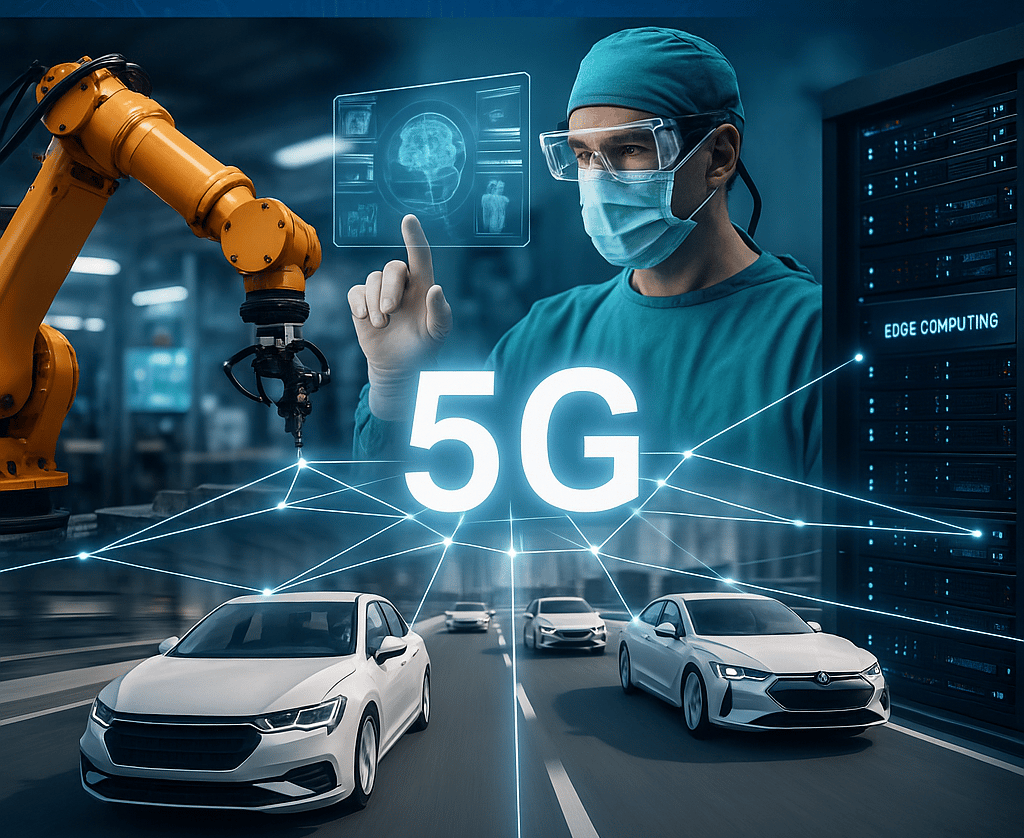How 5G Infrastructure and Emerging Tech Are Reshaping Our Future
The 5G infrastructure market, valued at $12.89 billion in 2024, will reach $52.87 billion by 2033, driven by AI, automation, edge computing, and rising demand in sectors like automotive, healthcare, and smart cities.
AITECH INFRASTRUCTURETECHNOLOGYARTIFICIAL INTELLIGENCE
Eric Sanders
6/16/20254 min read


The Future Is Connected: Why 5G Infrastructure Is Just Getting Started
The 5G infrastructure market isn’t just an industry trend—it’s a revolution in the making. With the global market projected to skyrocket from $12.89 billion in 2024 to $52.87 billion by 2033, it's clear that 5G is no longer just about faster mobile internet for consumers. It's about building the connective spine of the next-generation digital economy—one increasingly driven by AI, automation, and edge computing.
“The fusion of AI and 5G is transforming not just how we communicate, but how entire industries operate.”
As we look ahead, it's not just telecom carriers or tech giants who will feel the ripple effects. Sectors as diverse as automotive, healthcare, logistics, and municipalities are beginning to integrate 5G into the core of their operations, becoming smarter, faster, and more adaptive in the process. This isn’t business as usual. It’s a fundamental shift in infrastructure thinking.
From Consumer Data to Industry Backbone
When most people hear "5G," they immediately think about faster downloads or lag-free streaming. In reality, though, what’s happening behind the scenes is far more profound. Over the last few years, I’ve watched businesses announce 5G pilot programs, government proposals for smart city funding, and AI-integrated hospital systems reliant on uninterrupted, high-speed, low-latency connections.
What’s changing is not just the speed of the network—but what we can do with it.
In automotive: 5G plays a foundational role in the evolution of autonomous vehicles. Real-time communication between vehicles (V2V) and infrastructure (V2I) depends on ultra-reliable low-latency connections.
In healthcare: Remote surgeries, continuous patient monitoring, and AI diagnostics all require seamless data transfer that only 5G can provide.
In manufacturing and logistics: Smart factories are leveraging 5G combined with AI and automation to reduce downtime and improve productivity. Logistics companies use real-time tracking of goods and predictive maintenance of vehicles and equipment.
This multifaceted adoption underscores the fact that 5G is a catalyst—connecting the edge, the cloud, and AI-powered decision engines in real time.
The Synergy Between 5G and Emerging Technologies
One of the most fascinating dynamics in today’s digital landscape is how 5G isn't advancing alone—it’s accelerating in tandem with complementary innovations. Let’s take a closer look at the key technologies driving the growth.
Artificial Intelligence (AI): AI needs data—and lots of it—to generate insights, automate processes, and improve over time. 5G ensures that this data flows smoothly and rapidly between devices, sensors, and storage points.
Edge Computing: Instead of processing everything in the cloud, companies are moving increasingly toward edge computing to minimize latency. Edge and 5G combined allow processing to happen closer to where data is generated—in cars, manufacturing lines, or hospital beds.
Automation: Whether in form of robotics in factories or smart traffic signals in urban environments, automation depends on networks that can communicate with minimal interruption.
According to the recent report by OpenPR, these technologies are not only enhancing 5G’s capability but also fueling its adoption: “The integration of AI and automation into 5G networks has enhanced the efficiency, scalability, and responsiveness of connected environments.”
What This Means for Business and Society
The explosive growth in 5G infrastructure isn’t just about new hardware installations or shifting bandwidth. It signals deeper social and economic changes.
For enterprises: Those who invest in 5G readiness early could deliver new customer experiences, operate with greater efficiency, and gain competitive advantages in AI adoption, automation, and flexibility.
For cities: Urban planning will move into a data-first mindset. Smart cities equipped with 5G infrastructure can improve traffic management, public safety, energy conservation, and municipal services.
For workers and professionals: Expect a wave of new high-tech job roles—such as 5G network engineers, AI-5G integration specialists, and digital twins developers—driven by increasing demand for converged solutions.
In simple terms, this is not about one technology replacing another, but about building an ecosystem. 5G acts as the circulatory system for the tech body of the future—where every sensor, device, server, and user is synchronized.
What You Should Know About the 5G Boom
If you’re wondering how to make sense of the evolving 5G landscape, here are a few essential insights:
The 5G market is accelerating rapidly, with a projected CAGR that will see it quadruple in size by 2033.
AI, edge computing, and automation aren't separate trends—they're forming a single, interdependent growth engine with 5G at the center.
Industries embracing 5G today will be better positioned for market shifts, particularly in connected environments like smart cities, intelligent factories, and digital healthcare systems.
Adaptability is key. Organizations that apply flexible infrastructure strategies and are open to hybrid deployment models (like public-private edge cloud setups) will become the leaders of tomorrow.
“In the new digital economy, connectivity is not just infrastructure—it’s empowerment.”
Where Does That Leave You?
The big question isn't whether 5G will change the world. It already is. The real question is: Where will you be when it does?
Will you be a passive observer watching companies, institutions, and governments transform—accelerating productivity, inventing new services, and reinventing old ones? Or will you be a part of the change, leveraging the ecosystem that 5G and its partners—AI, automation, and edge computing—are building?
Because tomorrow's infrastructure isn't about concrete and steel. It's about bytes, bandwidth, and data flow. And it’s happening now.
What could your business (or your city, or your career) become if built on 5G instead of being left behind by it?
Efficiency
Transform your workflows and reclaim your time.
Contact Us
Need A Custom Solutions? Lets connect!
eric.sanders@thedigiadvantagepro.com
772-228-1085
© 2025. All rights reserved.
